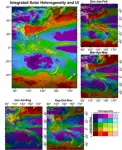(Press-News.org) A finding by a McGill-led team of neuroscientists could open doors to new treatments for a range of psychiatric and neurological disorders attributed to dysfunctions in specific dopamine pathways.
For those struggling with a psychiatric disorder such as schizophrenia, addiction or ADHD, or with neurological disorders such as Parkinson’s disease or Alzheimer’s, there might be good news ahead. The neuroscientists have discovered that a small group of dopamine neurons in the striatum play a crucial role in balancing several essential brain functions, including those related to reward, cognition and movement.
Dopamine is a messenger molecule that is often associated with pleasure and reward. But it plays an equally important role in mood regulation, sleep and digestion, as well as in motor and cognitive functions. An excess release of dopamine, induced by certain drugs or behaviours, is responsible for addiction. Conversely, its absence can cause profound alterations in motor control, as is the case in Parkinson's disease.
A critical balancing act
Scientists had previously identified the functions of two distinct pathways and types of dopamine receptors in the forebrain: the D1 receptors, which activate neurons, and the D2 receptors, which inhibit them. A third group of dopamine receptors that possess both D1 and D2 dopamine receptors was known to exist, but until now, no one had been able to identify their specific function.
By using innovative genetic tools to specifically target these dopamine receptors, which comprise just five per cent of the dopamine neurons in the striatum, the researchers were able to begin to understand their functions.
The researchers discovered that this group of neurons present unique cellular characteristics in response to dopamine and are at the origin of a new pathway that is essential for the balance of forebrain functioning. It ensures motor control under normal physiological conditions and curbs hyperactivity induced by psychostimulant drugs.
“Without these neurons, the entire brain systems under dopamine control would become overactive and uncontrollable, since they act to balance the functions of the two types of dopamine receptors in the brain which either facilitate or inhibit the activation of the two pathways we already knew of,” explains Bruno Giros, a professor in McGill’s department of psychiatry and a researcher at the Douglas Hospital Research Institute. He is the senior author of a recent article on the subject published in Nature Neuroscience. “It’s a very exciting finding for us because we’ve been working on this specific project for close to 10 years in collaboration with a team at Université Libre de Bruxelles (ULB).”
For Giros, the discovery comes after 30 years of work in the field, including alongside renowned neuroscientist Marc Caron and 2012 Nobel prize winner Robert J. Lefkowitz as a postdoctoral fellow at Duke University Medical Centre.
“We are only in the early days of working with the tools that we developed to help us to identify this pathway,” says Alban de Kerchove d’Exaerde from the Neurophy Lab at ULB, who collaborated on the research. “I'm sure that a lot of laboratories will work with our tools and will, with time, discover more about the important role that this very specific pathway plays in various fields,” Giros adds. “Now that we understand how this third pathway controls motor functions, the next goal of our research will be to understand more precisely how it is implicated in the control of cognitive processes, and how it could be impaired in psychiatric disorders.”
This research was supported by grants from the Canadian Institute for Health Research (CIHR) and the Graham Boeckh Foundation.
“Striatal projection neurons coexpressing dopamine D1 and D2 receptors modulate the motor function of D1- and D2-SPNs” by Bonnavion, P., Varin, C., Fakhfouri, G. et al was published in Nature Neuroscience
DOI: https://doi.org/10.1038/s41593-024-01694-4
END
The brain’s balancing system
Small number of dopamine neurons play a critical role in controlling a wide range of behaviours
2024-08-27
ELSE PRESS RELEASES FROM THIS DATE:
Bubbling, frothing and sloshing: Long-hypothesized plasma instabilities finally observed
2024-08-27
Whether between galaxies or within doughnut-shaped fusion devices known as tokamaks, the electrically charged fourth state of matter known as plasma regularly encounters powerful magnetic fields, changing shape and sloshing in space. Now, a new measurement technique using protons, subatomic particles that form the nuclei of atoms, has captured details of this sloshing for the first time, potentially providing insight into the formation of enormous plasma jets that stretch between the stars.
Scientists at the U.S. Department of Energy’s (DOE) Princeton Plasma Physics Laboratory (PPPL) created ...
Brain research: Study shows what your favourite film genres reveal about your brain
2024-08-27
Crime films, action films, comedies, or documentaries? A person's favourite film genre reveals a lot about how their brain works. This is the finding of a new study led by the Martin Luther University Halle-Wittenberg (MLU) that compared data on film preferences with recordings of the brain activity of around 260 people. Fans of action films and comedies reacted very strongly to negative emotional stimuli, while participants who favoured documentaries or crime films and thrillers had a significantly weaker reaction. The results were published in the journal "Frontiers in Behavioral Neuroscience".
Films are ...
Event horizon telescope makes highest-resolution black hole detections from Earth
2024-08-27
The Event Horizon Telescope (EHT) Collaboration has conducted test observations achieving the highest resolution ever obtained from the surface of the Earth, by detecting light from the centers of distant galaxies at a frequency of around 345 GHz.
When combined with existing images of supermassive black holes at the hearts of M87 and Sgr A at the lower frequency of 230 GHz, these new results will not only make black hole photographs 50% crisper but also produce multi-color views of the region immediately outside the boundary of these cosmic beasts.
The new detections, led by scientists from the Center for Astrophysics | Harvard & Smithsonian (CfA) that ...
EHT scientists make highest-resolution observations yet from the surface of Earth
2024-08-27
The Event Horizon Telescope (EHT) Collaboration has conducted test observations, using the Atacama Large Millimeter/submillimeter Array (ALMA) and other facilities, that achieved the highest resolution ever obtained from the surface of Earth [1]. They managed this feat by detecting light from distant galaxies at a frequency of around 345 GHz, equivalent to a wavelength of 0.87 mm. The Collaboration estimates that in future they will be able to make black hole images that are 50% more detailed than was possible before, bringing the region immediately outside the boundary of nearby supermassive black holes into sharper focus. They will also ...
A human-centered AI tool to improve sepsis management
2024-08-27
COLUMBUS, Ohio – A proposed artificial intelligence tool to support clinician decision-making about hospital patients at risk for sepsis has an unusual feature: accounting for its lack of certainty and suggesting what demographic data, vital signs and lab test results it needs to improve its predictive performance.
The system, called SepsisLab, was developed based on feedback from doctors and nurses who treat patients in the emergency departments and ICUs where sepsis, the body’s overwhelming response to an infection, is most ...
MIT Press’s Direct to Open (D2O) seeks funding to continue expanding access to leading scholarship in 2025
2024-08-27
At the MIT Press, we believe that everyone deserves access to scholarship. Our dedication to this mission remains strong as we head into the fourth funding cycle for Direct to Open (D2O), our model for open access monographs. Libraries and consortia can commit to support the program through November 30, 2024.
“Direct to Open is a game changer,” said Amy Brand, Director and Publisher at the MIT Press. “We know that open scholarship benefits authors, readers, and the academy at large. This is why we ...
Obesity and susceptibility to SARS-CoV-2
2024-08-27
A study finds an increased risk of developing a productive SARS-CoV-2 infection in obese people. Obesity is known to predict worse outcomes and higher mortality for those with COVID-19. Masanori Aikawa and colleagues sought to determine if obesity also affected the likelihood of getting ill in the first place. To investigate, the authors analyzed electronic medical records for 687,813 patients from the Mass General Brigham healthcare system, including 72,613 individuals with suspected SARS-CoV-2 exposure, 18,447 of whom tested positive. The authors limited their data to a timeframe before vaccination became widespread in Massachusetts, to avoid the possible confounding ...
Darwin’s longstanding interest in biological rhythms
2024-08-27
A close reading of Darwin’s work suggests a deep interest in cyclical events. Rhythmic phenomena in nature—today the subjects of the field of chronobiology—have been studied since at least the 18th century. In a perspective, Tiago Gomes de Andrade and Andrew D. Beale examined the writings and work of Charles Darwin to explore and share the eminent naturalist’s deep fascination with biological rhythms. Darwin’s work on the “sleep movements” in plants, published in 1880 with his son Francis is well known. This work examined the daily cycle of opening and closing of leaves. But as far ...
Insights from satellite data pave the way to better solar power generation
2024-08-27
Amidst the ongoing energy crisis and under the threat of climate change, exploiting renewable energy sources has quickly become a global necessity. Though our options are varied, solar energy seems to be our best bet—experts estimate that it may become our main energy source well before the turn of the century.
Despite its clear advantages, solar energy generation has some limitations. Much like the wind, solar irradiance in a given region can vary quickly depending on weather conditions, causing fluctuations in power ...
Cardiovascular disease disproportionately affects middle-income countries
2024-08-27
Sophia Antipolis, France – 27 August 2024: Cardiovascular disease (CVD) remains the most common cause of death across Europe but while CVD mortality rates are generally decreasing, the decline is much less in middle-income than in high-income countries, according to new data from the European Society of Cardiology (ESC) Atlas of Cardiology, published in the European Heart Journal.1
The fourth edition of ESC Atlas statistics again demonstrate that CVD is the most common cause of death in the 55 ESC member countries studied. There are over 3 million deaths due to CVD per year – the equivalent of 8,500 deaths per day – which represents 37.4% of all deaths annually. ...
LAST 30 PRESS RELEASES:
Tracing the quick synthesis of an industrially important catalyst
New software sheds light on cancer’s hidden genetic networks
UT Health San Antonio awarded $3 million in CPRIT grants to bolster cancer research and prevention efforts in South Texas
Third symposium spotlights global challenge of new contaminants in China’s fight against pollution
From straw to soil harmony: International team reveals how biochar supercharges carbon-smart farming
Myeloma: How AI is redrawing the map of cancer care
Manhattan E. Charurat, Ph.D., MHS invested as the Homer and Martha Gudelsky Distinguished Professor in Medicine at the University of Maryland School of Medicine
Insilico Medicine’s Pharma.AI Q4 Winter Launch Recap: Revolutionizing drug discovery with cutting-edge AI innovations, accelerating the path to pharmaceutical superintelligence
Nanoplastics have diet-dependent impacts on digestive system health
Brain neuron death occurs throughout life and increases with age, a natural human protein drug may halt neuron death in Alzheimer’s disease
SPIE and CLP announce the recipients of the 2025 Advanced Photonics Young Innovator Award
Lessons from the Caldor Fire’s Christmas Valley ‘Miracle’
Ant societies rose by trading individual protection for collective power
Research reveals how ancient viral DNA shapes early embryonic development
A molecular gatekeeper that controls protein synthesis
New ‘cloaking device’ concept to shield sensitive tech from magnetic fields
Researchers show impact of mountain building and climate change on alpine biodiversity
Study models the transition from Neanderthals to modern humans in Europe
University of Phoenix College of Doctoral Studies releases white paper on AI-driven skilling to reduce burnout and restore worker autonomy
AIs fail at the game of visual “telephone”
The levers for a sustainable food system
Potential changes in US homelessness by ending federal support for housing first programs
Vulnerability of large language models to prompt injection when providing medical advice
Researchers develop new system for high-energy-density, long-life, multi-electron transfer bromine-based flow batteries
Ending federal support for housing first programs could increase U.S. homelessness by 5% in one year, new JAMA study finds
New research uncovers molecular ‘safety switch’ shielding cancers from immune attack
Bacteria resisting viral infection can still sink carbon to ocean floor
Younger biological age may increase depression risk in older women during COVID-19
Bharat Innovates 2026 National Basecamp Showcases India’s Most Promising Deep-Tech Ventures
Here’s what determines whether your income level rises or falls
[Press-News.org] The brain’s balancing systemSmall number of dopamine neurons play a critical role in controlling a wide range of behaviours




